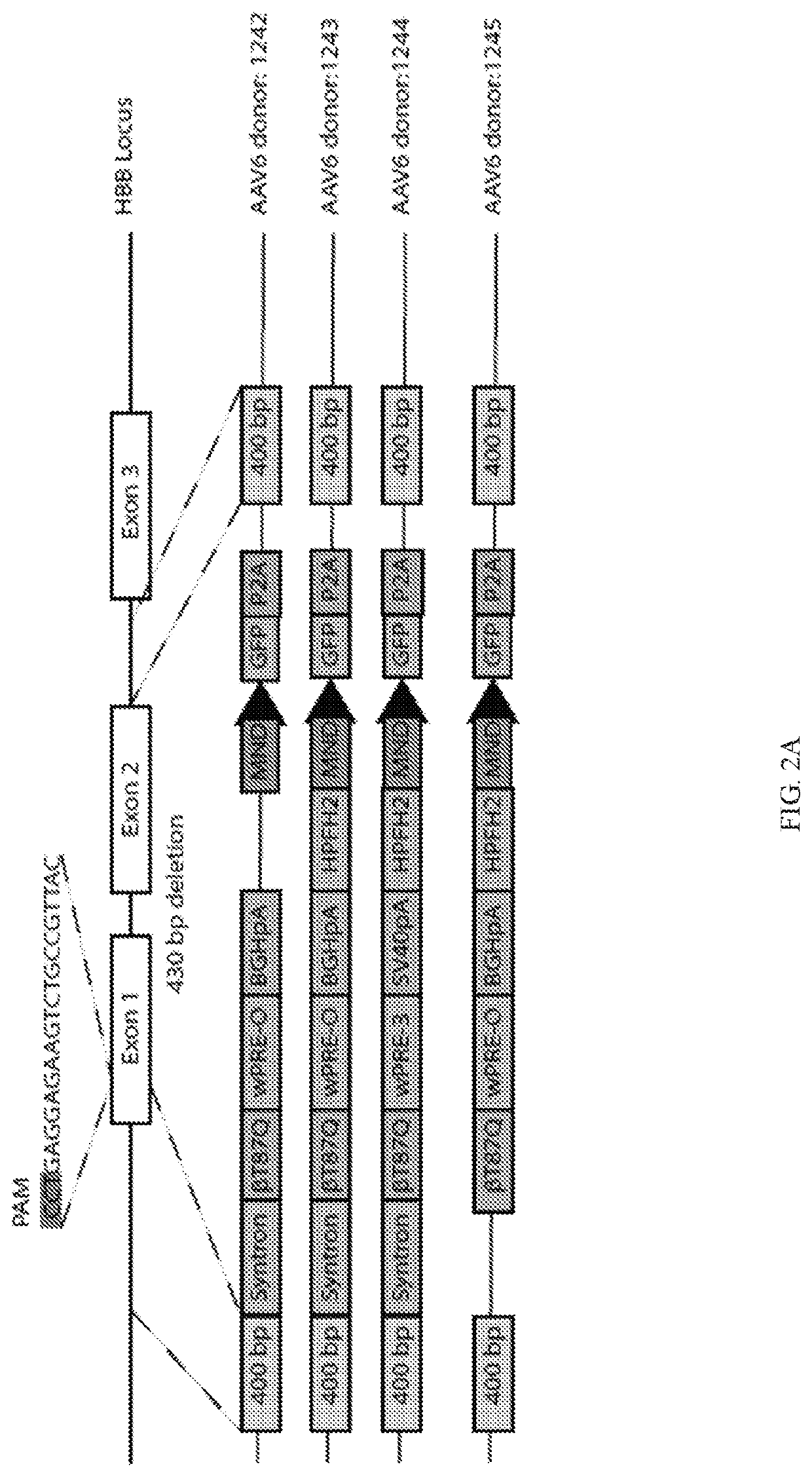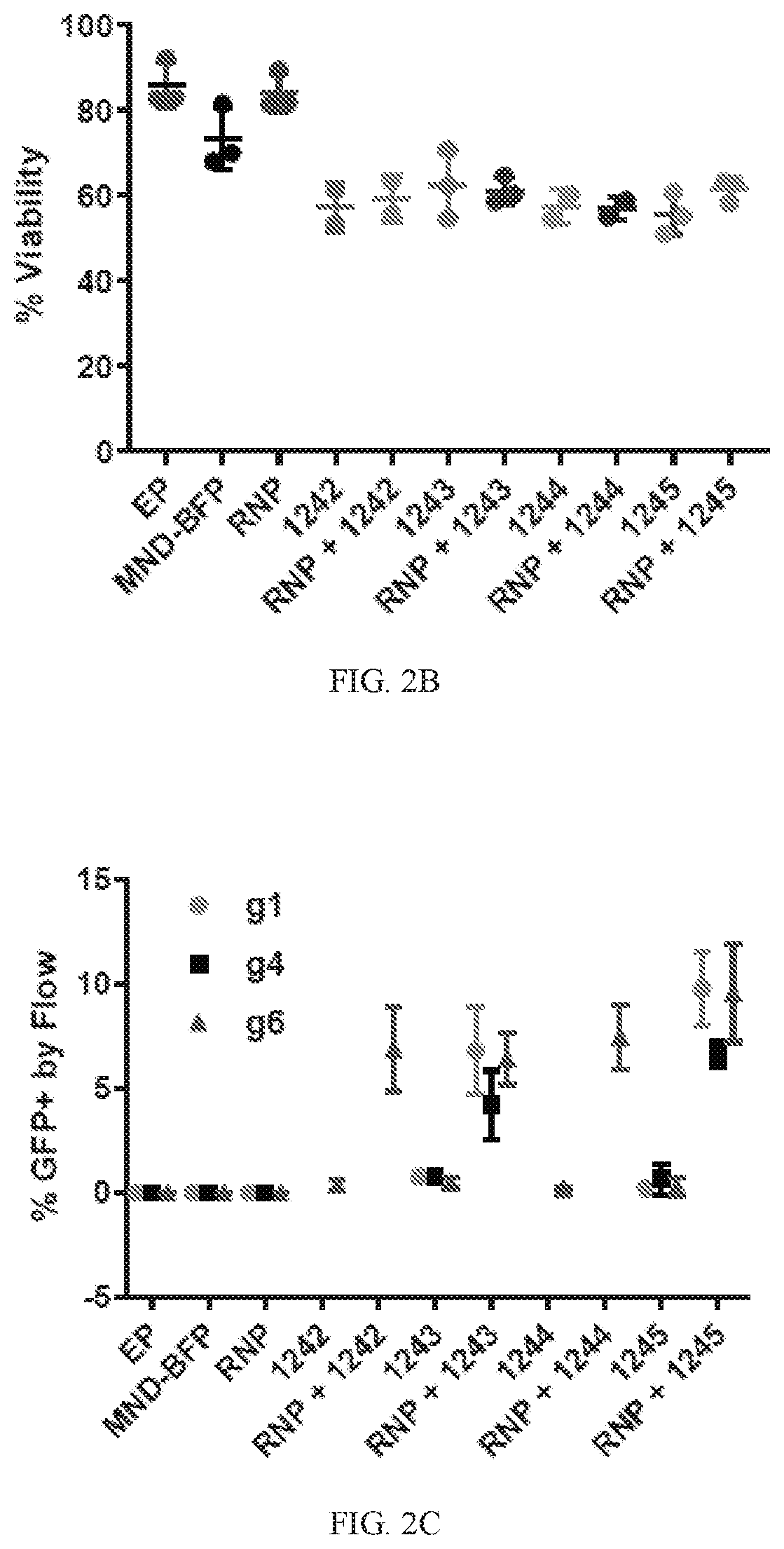Homology-directed repair template design and delivery to edit hemoglobin-related mutations
a technology of hemoglobin and repair template, which is applied in the direction of drug composition, peptide/protein ingredients, extracellular fluid disorder, etc., can solve the problems of hemoglobin abnormality in red blood cells, promote hdr of hbb gene, and improve the symptoms of sickle cell disease or disease. , to achieve the effect of promoting hdr, promoting hdr, and promoting hdr
- Summary
- Abstract
- Description
- Claims
- Application Information
AI Technical Summary
Benefits of technology
Problems solved by technology
Method used
Image
Examples
example 1
n of rAAV6 and ssODN for HDR at the β-Globin (HBB) Locus
[0188]The impact and clinical relevance of rAAV6 and ssODN delivery in correcting SCD was evaluated by introducing a E6V sickle mutation into human mobilized peripheral blood CD34+ cells (hPBSCs) using a Crispr / Cas9 ribonucleoprotein (RNP). Two donor delivery strategies were employed: a rAAV6 (AMS #1314) with 2.2 kb homology arms (HA) and a ssODN comprising 168 nucleotides (E7V-GTC and E7V-GTG change and V7E with CCCGAA change). The efficiency of HDR in comparison to residual NHEJ rates was evaluated following Crispr / Cas9 RNP generated double-stranded breaks (3% rAAV6, AMS #1314 and 12.5, 25, 50, or 100 pmol of ssODN).
[0189]Human mobilized peripheral blood CD34+ cells were thawed for 48 hours in SCGM media containing cytokines: 100 ng / ml of SCF, IL-6, Flt-3L, TPO. Cells were electroporated at 48 hours post-thaw and added to virus-containing recovery media (3% rAAV6, AMS #1314) for rAAV6 delivery. A dose titration of ssODN conta...
example 2
ate Design and Delivery to Edit and Correct the Sickle Mutation within the Exon-1 of the HBB Gene
[0191]To edit and correct a sickle mutation, nucleases that edit at the E7V mutation of the HBB gene were developed. Both TALENs as well as Crispr / Cas9 ribonucleoprotein-mediated delivery of chemically modified single guide RNA (sgRNA) were optimized to edit at exon 1 of the HBB gene. The data showed efficient editing at the sickle locus in K562 and human hematopoietic stem cells (CD34+). Various repair template architecture were designed for rAAV6-mediated delivery of novel HDR repair templates with unique regulatory elements. Anti-sickling (T87Q) globin cassettes, sickle globin introduction and sickle correction cassettes were tested at the HBB locus. The design of these templates was unique. Efficient, clinically-relevant rates of homology-dependent repair (HDR) at the HBB locus were achieved.
[0192]ssODN delivery of repair templates were also designed and optimized to drive HDR at the...
example 3
utcome of Homology-Directed Repair at the HBB Gene in HSC Using Alternative Donor Template Delivery Methods
Experimental Protocols
[0211]rAAV6 production: rAAV6 stocks were produced. The rAAV6 vector, serotype helper and HgT1-adeno helper plasmids were transfected into HEK293T cells. Cells were harvested at 48 hours, lysed and treated with benzonase. An iodixanol density gradient was used to purify the virions with recombinant rAAV6 genomes. The qPCR-based titers of rAAV6 genomes were determined by using ITR specific primers and probe. 1%, 2% and 3% of the culture volume were used for transducing rAAV6 into mPBSCs.
[0212]CD34+ hematopoietic stem cells: frozen mPBSC were purchased from Cooperative Center for Excellence in Hematology at Fred Hutchinson Cancer Research Institute, Seattle, Wash.
[0213]sgRNA and TALEN design: Guides were designed that were predicted to cut close to the sickle mutation using CRISPR design tools, (http: / / crispr.mit.edu / and http: / / crispor.tefor.net / ). All guid...
PUM
| Property | Measurement | Unit |
|---|---|---|
| temperature | aaaaa | aaaaa |
| temperature | aaaaa | aaaaa |
| pH | aaaaa | aaaaa |
Abstract
Description
Claims
Application Information
 Login to View More
Login to View More - R&D
- Intellectual Property
- Life Sciences
- Materials
- Tech Scout
- Unparalleled Data Quality
- Higher Quality Content
- 60% Fewer Hallucinations
Browse by: Latest US Patents, China's latest patents, Technical Efficacy Thesaurus, Application Domain, Technology Topic, Popular Technical Reports.
© 2025 PatSnap. All rights reserved.Legal|Privacy policy|Modern Slavery Act Transparency Statement|Sitemap|About US| Contact US: help@patsnap.com



